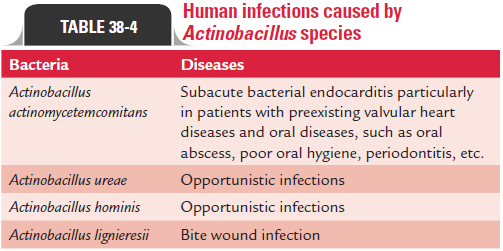Chapter: Microbiology and Immunology: Bacteriology: Haemophilus, Pasteurella, and Actinobacillus
Actinobacillus
Actinobacillus
Actinobacillus are small, nonmotile, and facultative anaerobicGram-negative bacilli. The bacteria grow slowly on culture media requiring 2–3 days of incubation. Actinobacillus are present in the oropharynx of humans and animals and cause a variety of infections. The genus Actinobacillus consists of at least six species, and Actinobacillus actinomycetemcomitans is the most important human pathogen. Other species cause very rare human infections (Table 38-4).

Actinobacillus actinomycetemcomitans
A. actinomycetemcomitans is relatively uncommon agent ofperiodontitis, endocarditis, and opportunistic infections in humans. A. actinomycetemcomitans is so named because the organism is frequently associated with actinomyces (Latin word: comitans means accompanying). The bacteria in humans con-stitute the normal flora of the oral cavity, particularly in the gingival and supragingival cervices.
actinomycetemcomitans grows slowly on chocolate andblood agar producing demonstrable colonies after 2–3 days of incubation. On blood agar, the colonies are smooth, trans-lucent, and nonhemolytic with irregular edges. It does not require X or V factors, but an increased concentration of CO2 for better isolation of the colonies. It fails to grow on MacConkey agar.
actinomycetemcomitans is indole negative, urease negative,citrate negative, aesculin negative, and also lysine, ornithine, and arginine negative. It is catalase positive and nitrate reduc-tase positive. It shows a variable oxidase reaction. It ferments glucose, but does not ferment lactose or sucrose.
actinomycetemcomitans can cause subacute bacterialendocarditis particularly in patients with preexisting val-vular heart diseases and oral diseases, such as oral abscess, poor oral hygiene, periodontitis, etc. The bacteria invade oropharynx and blood stream, adhere to the damaged heart valves, and cause the disease. The bacteria are suscep-tible to aminoglycosides, third-generation cephalosporins, quinolones, chloramphenicol, and tetracyclines. Strains resistant to ampicillin are treated with cephalosporins or fluoroquinolones.
Differential features of important Haemophilus, Pasteurella, and Actinobacillus species are summarized in Table 38-5.

Related Topics